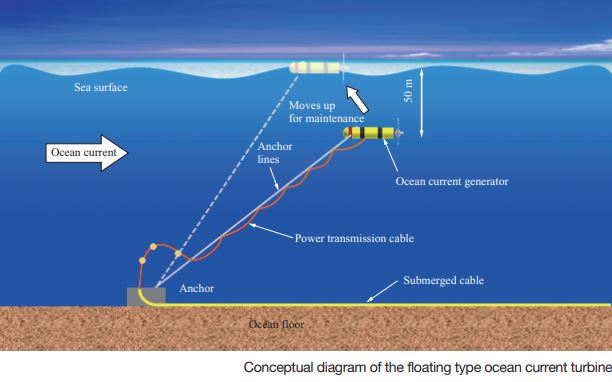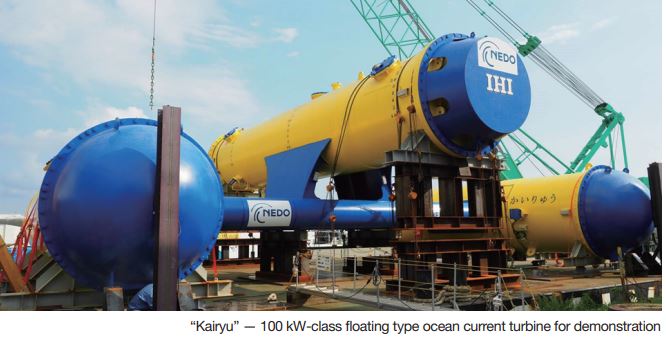Japan Digs Deep Into The Ocean For A New Stream Of RE


Japan has finally found a steady source of renewable energy deep into the ocean regardless of the wind or sun. Working for more than a decade, Japanese heavy machinery maker IHI Corp. has developed a subsea turbine that harnesses the energy in deep ocean currents to convert it into a steady and reliable source of electricity. The prototype could generate the expected 100 kilowatts of stable power.
Called Kairyu, the developed machine resembles an airplane, with two counter-rotating turbine fans in place of jets, and a central ‘fuselage’ housing a buoyancy adjustment system and is designed to be anchored to the sea floor at a depth of 30-50 meters (100-160 feet). Japan’s New Energy and Industrial Technology Development Organization (NEDO) estimates the Kuroshio Current could potentially generate as much as 200 gigawatts — about 60% of Japan’s present generating capacity. While tidal flows don’t run 24 hours, they tend to be stronger than deep ocean currents. The Kuroshio current flows at 1 to 1.5 meters per second, compared with 3 meters per second for some tidal systems.
A variety of approaches to the realization of ocean renewable energy have been proposed. Approaches include ocean current power generation, which uses a big ocean current in the open sea, such as the Kuroshio, to rotate turbine rotors; tidal flow power generation, which uses tidal flow in a strait or the like to rotate turbine rotors; wave activated power generation, which uses the vertical motion of waves; ocean thermal energy conversion, which uses the temperature difference between surface and bottom; tidal (level difference) power generation; and seawater concentration difference power generation.
“Ocean currents have an advantage in terms of their accessibility in Japan,” said Ken Takagi, a professor of ocean technology policy at the University of Tokyo Graduate School of Frontier Sciences.
The ocean currents flow with little fluctuation in speed and direction, giving them a capacity factor — a measure of how often the system is generating — of 50-70%, compared with around 29% for onshore wind and 15% for solar. Among marine-energy technologies, the one advancing fastest towards cost-effectiveness is tidal stream, where “the technology has advanced quite a long way and it definitely works. “The biggest issue for ocean current turbines is whether they could produce a device that would generate power economically out of currents that are not particularly strong,” said Angus McCrone, a marine energy analyst.
Ocean Energy Systems, an intergovernmental collaboration established by the International Energy Agency, sees the potential to deploy more than 300 gigawatts of ocean energy globally by 2050.




